History of Gion Jinja
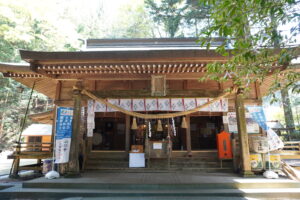
Mount Gion, “The beginning of Kyushu,” as it was the first to rise from the ocean. It is one of the oldest geological formations in Japan where 430-million-year-old Kusari (chain) coral fossils were excavated. Ancient people enshrined Gozusoo shin and the brothers, Somin Shorai and Kotanshorai, as local guardian deity of “Chihogo-keniki (Chihogo township area)” which includes the former Seiwa Village of Kumamoto prefecture, Soyo Town, and part of Takachiho Town, encircling this sacred mountain. In 530, during the reign of Emperor Kinmei, they built “Gionsha” which became the foundation of “Gion Jinja.”
Main pavilion
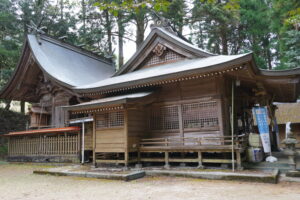
In 1578, soldiers of Ōtomo Sōrin (a Japanese feudal lord of the Ōtomo clan) burned down this shrine and three other shrines. The deities were enshrined in the northern hall of Tokoji temple until 1720 when the shrines were rebuilt. In 1835, only a single large Keyaki tree of the northern hall was used to rebuild the current pavilion. Also, the gate for Konko temple which is located next to Ichi no torii was built with leftover wood from making the pavilion.
The Shrine Grounds
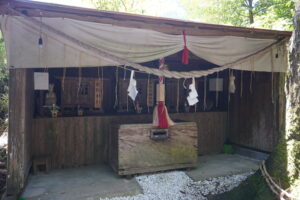
Kogamure Jinja
Legend of Yamata no Orochi (a gigantic serpent with eight heads and eight tails) originated near Kamuredake. Spirits of Kanhachimen Daimyojin and Kuraokami no kami from Kogamure Jinja located at the base of Kamuredake are enshrined here. “Okami” refers to Ryujin sama. It has been said that Kuraokami no kami is the Seoritsu hime (Princess Seoritsu), Aramitama of Amaterasu Omikami. “Kogamure Shinko” have been worshipped from as a deity that wards off plague and disease together with Kuraokami no kami.
Myoken Jinja
Rainwater is absorbed by Mount Gion then runs underground a few kilometers and gushes from a purified spring. The spirit of water deity, Mizuhanome no kami, is enshrined at the spring in Myoken Jinja. Mizuhanome no kami is also said to be the same as Seoritsu hime.
Gongen Jinja
Kumano Sansha Gongen(Ketsumiko-no-Okami, Miko-Hayatama-no-Okami Kumano Fusumi-no-Okami of Nachi Kumano, ) World Heritage sites are worshipped in Gongen Jinja.
Oyamazumi Jinja
The deity of the mountain called Ohyamazumi no kami is enshrined
Tenman Tenjin
Lord Michizane Sugawara is worshipped as “Tenmansama” and “Tenjinsama” in Tenman Tenjin.
Ikime Daimyojin
The spirit dedicated to the deity of eyes; Ikime Hachimangu in Miyazaki (currently called Ikime Jinja) is worshipped here.
Deity of safe childbirth
The deity of fertility, childbirth, and parenting Empress Jingu`s enshrine.
Gion Kagura
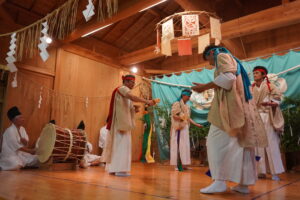
Gion Kagura is a valuable style of Kagura passed down through the generations as a unique form of Kagura. It has adopted ancient music of Kyoto culture which inherits elements of Ise Kagura with dances and music of Izumo Kagura merging with Takachiho Kagura and Iwato Kagura.
The basic of Kagura called Shikisanban is performed in three parts “Jigakura” “Bagakura” and “Jikoshin” at festivals.
The thirty-second part of thirty-three part performance is called “Maibiraki” and is only performed for Gion Kagura where child will dress as Amaterasu Omikami reacting her being led out by Tajikarao no Mikoto from Iwato by hand.
Bōjutsu (Stick fighting)
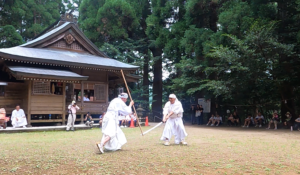
Bōjutsu training of menkyo-kaiden (full proficiency) in “ShinKage Muso Taisharyu” has been passed down through the generations in Kuraoka. There are several disciplines in Bōjutsu. One of the theories explains that this style was developed to protect Heike fugitives themselves and Kousekikou Bōjutsu called “Musoryu” from Kosekiko of To (Tang) was introduced along with “Shinkageryu” of Isenokami Kamiizumi (legendary sword master) during Genpai war. Another theory says that a pupil of Isenokami Kamiizumi named Marume Kurando came and created “Taisharyu.” In 1831, Ichinoin Tomosada swordplay with Bo staffs as “ShinKege Muso Taisharyu.”
In any of these disciplines, the long Bo staff is 182cm and the half staff is 91cm. The style of this Bōjutsu is to protect from long swords or spears using the Bo staffs. There are more than 30 different types of Bo-Jyutsu including long staff vs long staff, long staff vs half staff, and long staff vs sword. The style uses sword is called “Shiraha”
It’s been said that the same style existed in Hitoyoshi Sagara village before, but it only remains in Kuraoka today.
The Bo staffs are carried by the guards during “Gionmatsuri” summer festival of parade called Shinkosai. After the parade, they also perform “ShinKage Muso Taisharyu” a form of Bōjutsu in the courtyard.
Usudaiko Odori (Usu dram dance)

Kuraoka is also known as the land of Heike fugitives. In 1185, Heike fugitives who were defeated by Danoura left women and children behind whom could not walk well on rough mountain trails on the way to Shiiba beyond Kuraoka. In 1205, Daihachirou Nasu (a warrior from the Genji Clan) and his military tracked down Heike Clan to Kuraoka but saw that they had no will to fight; instead, they began to celebrate by dancing remembering the capital. This dance became the basis of Usudaiko Odori and has been passed down gone through changes until today. Varity of songs and dances are performed at fall festival “Okunchi” praying for good harvest, safety and fulfillment.
Tree planted by Daihachiro Nasu
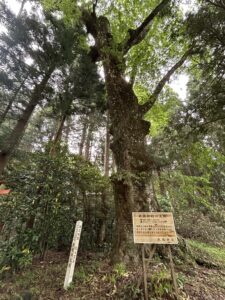
Daihachiro Nasu arrived in Kuraoka under the command of the Heike Clan. Upon arriving, he said, “it is difficult to go any further with the horse” and got off the horse. He then prayed at Gionsya for his victory and planted a Japanese keyaki which still exists in the pavilion. He continued his way to Shiiba village, site of a tragic love story between Daihachiro Nasu of the Genji Clan and Princess Tsurutomi of the Heike Clan.
Nio zou, Yakushi Nyorai zou
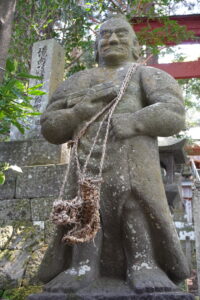
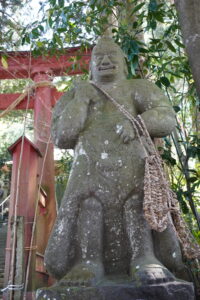
Fudomyoo zou (Statues of Two Deva Kings, Bhaisajyaguru, Acalanatha)
The statues of Nio are enshrined in front of San no Torii (it is a unusual shape of gate called Ryobu torii) at the Gion Jinja which is rare for shrine. Also, the statues of Yakushi Nryorai and Fudo myoo are enshrined at shrine office. Japanese believed that “Deity” and “Budda” coexist since that Buddhism is introduced to Japan. This simple concept of syncretism continues to make various transitions until separation of Shintoism and Buddhism by Haibutsu-kishaku (movement to abolish Buddhism.) Nio, Yakushi nryorai and Fudomyoo are still enshrined at Gion Jinja even after Haibutsu-kishaku.
Morimakishinji
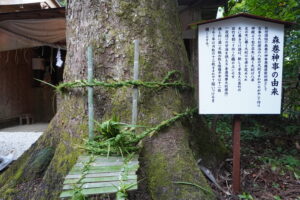
This ritual is performed prior to Kaki no reitai-sai (Summer festival) called “Gion-san” held on July 15th. There is a legend of Yamata no Orochi in Kuraoka. A legendary story associated with Susano no Mikoto slaying Yamata no Orochi, the ritual of praying ward off evil spirits has been passed down for a long time.
People from “Yasouzonogumi” weaves “Makaya” (short congo grass) to make Yamata no Orichi and wrapped them around the trees of the Kogamure Jinjya. The size of Yamato no Orichi is determined by the side of the tree, on the right side is 14.4m and left side is 12.6m. The heads are placed on the bridge made of newly grown giant timber bamboo boards tying them with thatch. The number of boards used to weave the bridge are determined by the year, in a lunar year, there are 12, and a leap year is 13. Ama sake made over night is offered to the Yamate no Orochi reproducing Susano no Mikoto slaying Orochi.
After the Morimaki ritual is finished, a sumo wrestling ring is created with Makaya and Sumo tournament is held. The number of matches is also determined by the year. A lunar year has 12 matches and for a leap year has 13, children to adults are welcome to participate. The role of sumo referees called Tategyouji and Fukugyouji are passed down from generations to generations.